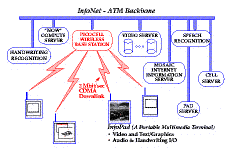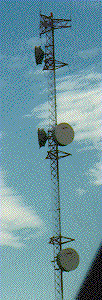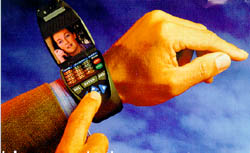
 | JPL's Wireless Communication Reference WebsiteChapter: Network Concepts and Standards. Section: Wireless LANs. |
![]()
With contributions by Torben Rune, Netplan.
Personal computer networking is undergoing a drastic transformation in response to end users' need for mobility and connectivity. During 1996, Europe will see the establishments of wireless data networks based on standards such as DECT and the 2.45 GHz ETSI standard. Forthcoming standards that cater for interoperability of different manufacturers' equipment will grow the cordless networking market to an important telecommunication market, giving the mobile computing environment the same wireless lift as has GMS to the voice market.
Today's typical LAN environment require costly planning and investment to build and maintain. Radio-based LANs might soon become a more flexible and even less expensive option in dynamic environments, than today's cable based systems. As production facilities grow more and more based on information technology, having a local area network becomes increasingly crucial to ensuring things like teamwork, workflow and decision support and even for practical purposes like backup of enterprise data and important IT-based production tools. As enterprises grow, their needs for office space or larger production facilities rise. At the same time, the enterprises knowledge of the direction or scale of the coming growth might be limited. In such an environment, small companies may find it very hard to pick the right time when the company is able to absorb the high cost of establishing or expanding a cable-based LAN.
The emergence of radio based LAN communications products is set to offer enterprises the option of building their LANs on more flexible and maybe even cheaper wireless technology. With wireless technology, businesses might also reduce the total planning costs (where to put cables and where their PC’s, printers and so on). Wireless technology will also make it less demanding to move computer equipment to new locations, that lack easy access to LAN cables.
Other possible applications of wireless technology in general are in public institutions that currently have little or no infrastructure. Microsoft Corporation stated in a discussion "that a wireless broadband network is potentially the only economically practical means of disseminating multimedia data within a classroom."
 |  The Infopad project at
U.C. Berkeley is an
example of a project
addressing the development of cheap
handheld multimedia terminals
providing access to a multimedia
computing infrastructure. One
important application is in a
classroom. Radio downlinks (ceiling
base station to pad) is designed for 2
Mbit/s real-time video transmission. The Infopad project at
U.C. Berkeley is an
example of a project
addressing the development of cheap
handheld multimedia terminals
providing access to a multimedia
computing infrastructure. One
important application is in a
classroom. Radio downlinks (ceiling
base station to pad) is designed for 2
Mbit/s real-time video transmission. |
Emerging wireless technologies share some of the potentials and challenges of other technologies where the end-user products are in the process of being miniaturized. The potential is, that miniaturization can lead to replacing today’s bulky equipment with more transportable equipment that are generically portable. While this may lead to rising usability of Wireless products for consumers, it also raises the challenges of honoring a number of technical and regulatory requirements. Just to mention a small obstacle, international and national telecommunications authorities require that official stickers be placed directly on the product to show the consumer, that the product has been tested and approved. As the products get smaller, the challenge of finding space for such stickers becomes greater.
The Wireless technology is still in its infancy. Existing wireless equipment manufacturers only offer proprietary products. In fact, the technology is today primarily known and used for military and exotic purposes.
One of the biggest barriers to the growth and diffusion of this technology is the lack of standardization. The lack of current standards raises the risk for business consumers wishing to take advantage of this exciting technology. They might find, that the products of today might not be able to work with the standards of tomorrow.

 Personal Digital Assistants are rapidly entering the market. Currently, wireless links are mostly provided by add-on radio modem, but may soon be integrated. Photo: Philips Velo | A recent survey shows that the most widespread use for wireless technology today is for E-mail, leased-line replacement, Internet access and wired LAN replacement (each used by 1/3 of users polled). At the same time only very few use wireless technology for vertical market (transportation, insurance sales, etc.) and disaster recovery. Just under half of the users polled state, that they have introduced wireless technology in order to reduce line costs (see: last mile), while just over half in another question state that the cost of wireless is keeping them from investing in the technology. |
Once standards are adopted, economics of scale set in and businesses slowly adapt to wireless LAN technology, new exiting products and applications will surely emerge.
Wireless Local Area Networks have been around for a number of years. However, the wireless LAN market is expected to take off during 1996. There are several reasons for this, but the most obvious one might be the rapid evolution in mobile computing. In Europe, regulatory considerations have also prevented the introduction of wireless LANs.
When wireless LANs were introduced on the market in the end of last decade, most products were designed to be used together with stationary desktop computers. Their main objective was to offer flexible and cost-effective alternatives to the LAN cable. Aside from saving the often high costs of installing and maintaining the cable, another benefit of wireless LANs was the speed and ease with which new LANs could be created or new computers added.
 These benefits are of course still valid today, but office
computing is changing at an amazing pace. Advances in
low power microprocessors, display quality and battery
technology are resulting in extremely powerful notebook
PCs. Consumer electronics and personal computers are
merging to create an even smaller class of computing
products, the Personal Digital Assistants (PDAs). Through
the integration of telephone and multi-media technology in these devices, intelligent
terminals for telecommunication services are created.
These benefits are of course still valid today, but office
computing is changing at an amazing pace. Advances in
low power microprocessors, display quality and battery
technology are resulting in extremely powerful notebook
PCs. Consumer electronics and personal computers are
merging to create an even smaller class of computing
products, the Personal Digital Assistants (PDAs). Through
the integration of telephone and multi-media technology in these devices, intelligent
terminals for telecommunication services are created.
Users need the freedom to move about the workplace unencumbered by network cable and power cords. Yet, they require timely access to all of the business information. This type of mobile computing has placed an entirely new set of demands on office LANs, among those: higher data-rates, more reliable services, shorter wavelength i.e. shorter antennae etc.
A number of application areas for wireless LANs have been envisaged. Except from the office environment, wireless LANs are today used in hospitals to provide personnel with the possibility to gain access to information such as patient records on the move. Similar needs are expressed by personnel working at airports, construction areas, universities etc. Wireless LANs are also used together with bar-code readers in supermarkets or vehicular mounted on mobile cranes and forklift trucks. Another application area for wireless LANs are to bridge between cabled LANs in different buildings. Ad-hoc networking is another application, which is expected to take advantage of the wireless connection.
Ad-hoc networking is what happens when two or more workstations join the same network, forming the network at the time it is needed. That network exists only as long as there are stations in it.
The need for bandwidth in LAN based communication equipment has been constantly rising. New user-friendly technology such as graphics based documents and program- interfaces have strained many existing LAN infrastructures and the emergence of real time high definition video transmissions are sure to strain these infrastructures further.